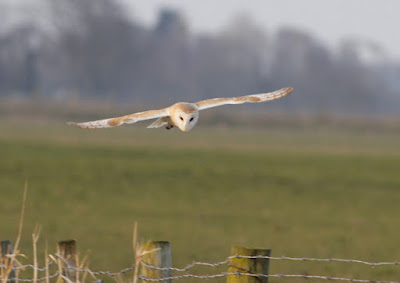This morning I set off birding on a regular route north over Stalmine Moss. A telegraph pole Kestrel was the first notable bird, unless I was to count common Blackbirds. There’d been a few near misses of the dark shapes along the way. It’s one of the perils of early morning driving along country lanes in the half light of a springtime morning where Blackbird territories seem to be not linear but to criss-cross east to west almost immediately in front of a moving vehicle.
Next came a pair of Little Owls sat in a tree alongside Union Lane. The owls may have changed their affections in recent years by crossing to the other side. It was in 2008 and then in 2012 when Will and I found youngsters squashed into the roof space of an outbuilding to the south of the road, but extricated them in order to ring each one. Nowadays the regular Little Owls of the birding tourist trail hang out to the north of the road at a different farm - unless of course there’s more than one pair of Little Owls in the Fylde?
Little Owl
I tuned right at Lancaster Lane where an early morning togger was on the prowl for an owl or two. A veritable enthusiast and probable expert judging by the car complete with an impressive “OWL” number plate. I turned tail and headed for Cockerham and Moss Edge just in time to see a Barn Owl fly off in the direction of Lancaster Lane. Maybe OWL would see an owl after all?
Barn Owl
Along Moss Edge was a familiar car so I braked – JR working on a Saturday morning while I worked at birding – such dedication from both. I relayed news of the Barn Owl from two minutes before and then set off towards Braides and Conder Green.
Beyond Braides Farm were several thousand grey geese where a couple of hours with a scope might reveal an intruder or two amongst the majority pinkfeet. I heard tell lately that thousands of Pink-footed Geese and good numbers of Whooper Swans remained in Iceland during their mild mid-winter when normally both species would migrate and remain here in the UK until March and April.
On the Braides fields I counted 24 Lapwing, 2 Grey Heron and 1 Little Egret.
Before hitting Conder Green I detoured around Moss Lane and then Jeremy Lane where as luck would have it there appeared another Barn Owl. The light was better now.
Barn Owl
At Conder Green all appeared as mostly normal - 52 Teal, 120 Curlew, 30 Wigeon, 2 Little Grebe, 18 Redshank, 1 Spotted Redshank, 8 Oystercatcher, 2 Grey Heron and 2 Pied Wagtail. A flight of 140+ Black-tailed Godwits appeared as if from nowhere but as they turned and headed down I could see they were about to land in the still wet fields south of the canal.
Black-tailed Godwits
On the way back towards Pilling the Linnets at Wrampool were as flighty as ever with about 40 today along with a singing and territorial Pied Wagtail plus a patrolling Kestrel.
At Fluke Hall Lane and Backsands Lane - 26 Curlew, 44 Redshank, 26 Lapwing, 350 Pink-footed Geese plus at the hall itself a calling Nuthatch in amongst the nest boxes.
Pink-footed Geese
Please visit Another Bird Blog soon for more birds and owls. There’s always one but sometimes two, three or even four.

















































































